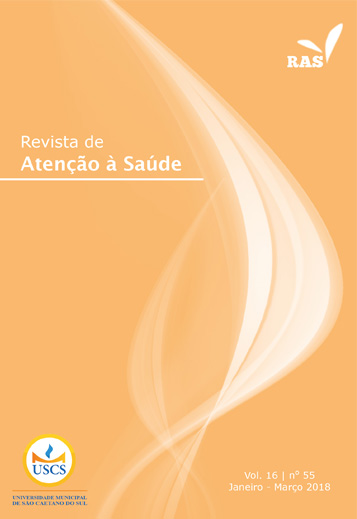SYNESTHESIA AND THE AUTISM SPECTRUM DISORDER (ASD)
DOI:
https://doi.org/10.13037/ras.vol16n55.4852Keywords:
Synesthesia, perception, autism, psychology, neurologyAbstract
Introduction: Synesthesia, which has a prevalence of 4%, is a neurological condition in which a single stimulus elicits additional experiences from another sensory sense, which can be: visual, auditory, olfactory, gustatory and tactile. This condition is not included in the DSM-5, however, its neurological bases may be linked to some behavioral disorders present in other disorders, such as Autism Spectrum Disorder (ASD). Objective: To perform a literature review on synesthesia and its possible correlation with ASD. Materials and methods: A bibliographic survey was carried out through the electronic databases: PubMed, Science Direct, SciELO, Google Academic and Research Gate, including articles and books, published in Portuguese and English. Between 1995 and 2015, to document synaesthesia and ASD. Results: To compose the present review, 37 articles and 4 books, national and international were included. Studies have shown that the prevalence of synesthesia is higher in autistic individuals. Other results point to similarities in the neurological and genetic bases involved in ASD and synesthesia, which explain altered sensorial perceptual processing in both. Conclusion: In this article, therefore, it was seen through different studies that synesthesia and TEA may present a correlation and that its aspects present a challenge for future research.
Downloads
References
Simner J, Mulvenna C, Sagiv N, Tsakanikos E, Witherby SA, Fraser C, et al. Synesthesia: the prevalence of atypical cross-modal experiences. Perception.2006;35(8):1024-33.
Ramachandran VS, Hubbard EM. Neurocognitive mechanisms of synesthesia. Neuron. 2005;48(3):509-20.
Guimarães B. Todos os sentidos. Superinteressante. 2003;185:45-8.
Hubbard E. Neurophysiology of synesthesia. Curr Psychiatry Rep. 2007;9(3):193-9.
Rouw R, van Driel J, Knip K, Ridderinkhof KR. Executive functions in synesthesia. Conscious Cogn. 2013;22(1):184-202.
Day SA. Some demographic and socio-cultural aspects of synesthesia. In: Robertson LC, Sagiv N, editors. Synesthesia: perspectives from cognitive neuroscience. Oxford University Press; 2005.
Asher JE, Lamb JA, Brocklebank D, Cazier J-B, Maestrini E, Addis L, et al. A whole-genome scan and fine-mapping linkage study of auditory-visual synesthesia reveals evidence of linkage to Chromosomes 2q24, 5q33,6p12, and 12p12. Am J Hum Genet. 2009;84(2):279-85.
Ramachandran VS, Hubbard EM. Ouvindo cores e degustando formas. Sci Am Brasil. 2003;2:48-55.
Bragança GF, Fonseca GM, Caramelli P. Synesthesia and music perception. Dement Neuropsychol. 2015;9(1):16-23.
Ramachandran VS, Hubbard EM. Psychophysical investigations into the neural basis of synesthesia. Proc Biol Sci.2001;268(1470):979-83.
Hubbard EM, Brang D, Ramachandran V. The cross-activation theory at 10. J Neuropsycol. 2011;5(2):152-77.
Maurer D, Spector F. Synesthesia: a new approach to understanding the development of perception. Dev Psychol. 2009;45(1):175-89.pheno
Cytowic RE. Touching tastes, seeing smells and shaking up brain science. New York: The Dana Fundation; 2002.
American Psychiatric Association. Manual diagnóstico e estatístico dos transtornos mentais (DSM-5). Porto Alegre: Artmed; 2014.
Cytowic RE. Synesthesia: phenomenology and neuropsychology. Psyche. 1995;2(10).
Neufeld J. Is synesthesia more common in patients with Asperger syndrome? Front Hum Neurosci. 2013;7:847.
Caminha RC, Lampreia C. Autismo: um transtorno de natureza sensorial? [dissertação]. Rio de Janeiro (RJ): Pontifícia Universidade Católica; 2008.
Belmonte MK, Allen G, Beckel-Mitchener A, Boulanger LM, Carper RA, Webb SJ. Autism and abnormal development of Brain connectivity. J Neurosci. 2004;24(42):9228-31.
Simmons D. Vision research: Vision in autism spectrum disorders. Elsevier. 2009;49(22):2705-39.
Mulvenna CM, Walsh V. Synesthesia: supernormal integration? Trends Cogn Sci.2006;10(8):350-2.
Casanova M, Trippe J. Radial cytoarchitecture and patterns of cortical connectivity in autism. Philos Trans R Soc London B Biol Sci. 2009;364(1522):1433-6.
Heer J. A review of synesthesia [Internet]. 2000 [citado em 2018 mar 15]. Disponível em: https://goo.gl/iubWYq
Baron-Cohen S, Burt L, Smith-Laittan F, Harrison J, Bolton P. Synaesthesia: prevalence and familiality. Perception. 1996;25(9):1073-80.
Grossenbacher PG, Lovelace CT. Mechanisms of synesthesia: cognitive and physiological constraints. Trends Cogn Sci. 2001;5(1):36-41.
Barnett KJ, Finucane C, Asher JE, Bargary G, Corvin AP, Newell FN, et al. Familial patterns and the origins of individual differences in synaesthesia. Cognition. 2008;106(2):871-93.
Gregersen PK, Kowalsky E, Lee A, Baron-Cohen S, Fisher SE, Asher JE, et al. Absolute pitch exhibits phenotypic and genetic overlap with synesthesia. Hum Mol Genet.2013;22(10):2097-104.
Ward J, Simner J. Is synaesthesia an X-linked trait with lethality in males? Perception.2005;34(5):611-23.
Garcia PM. Principais causas neurológicas do autismo. Anais do 8º Seminário de Pesquisa em Artes da Faculdade de Artes do Paraná; 2012; Curitiba: FAP; 2012. p. 256-9.
Carvalheira G, Vergani N, Brunoni D. Genética do autismo. Rev Bras Psiquiatr 2004;26(4):270-2.
Annunciato NF. Estruturas nervosas comprometidas no autismo: um enfoque neurogenético. Infanto – Rev Neuropsiq Inf Adol. 1995;3(3):38-52.
Moura PJ, Sato F, Mercadante MT. Bases neurobiológicas do autismo: enfoque no domínio da sociabilidade. Caderno de Pós-Graduação em Distúrbios do Desenvolvimento. 2005;5(1):47-57.
Garcia PM, Mosqueira CFF. Causas neurológicas do autismo. O Mosaico. 2011;(5):106-22.
Dalgalarrondo P. Evolução do cérebro: sistema nervoso, psicologia e psicopatologia sob a perspectiva evolucionista. Porto Alegre: Artmed; 2011.
Herculano-Houzel S. O cérebro em transformação. Rio de Janeiro: Objetiva; 2005.
Coutinho JVSC, Bosso RMV. Autismo e genética: uma revisão de literatura. Revista Científica do ITPAC. 2015;8(1):1-14.
International Molecular Genetic Study of Autism Consortium. A genomewide screen for autism: strong evidence for linkage to chromosomes 2q, 7q and 16p. Am J Hum Genet. 2001;69(3):570-81.
Baron-Cohen S, Johnson D, Asher J, Wheelwright S, Fisher SE, Gregersen PK, et al. Is synaesthesia more common in autism? Molecular Autism. 2013;4:40.
Marco EJ, Hinkley LB, Hill SS, Nagarajan SS. Sensory processing in autism: a review of neurophysiologic findings. Pediatr Res. 2011;69(5 Pt 2):48R-54R.
Klintwall L, Holm A, Eriksson M, Carlsson LH, Olsson MB, Hedvall A, et al. Sensory abnormalities in autism. A brief report. Res Dev Disabil. 2011;32(2):795-800.
Bouvet L, Donnadieu S, Valdois S, Caron C, Dawson M, Mottron L. Veridical mapping in savant ablilities, absolute pitch, and synesthesia: an autism case study. Front Psychol.2014;5:106.
Mottron L, Bouvet L, Bonnel A, Samson F, Burack JA, Dawson M, et al. Veridical mapping in the development of exceptional autistic abilities. Neurosci Biobehav Rev. 2013;37(2):209-28.
Downloads
Published
Issue
Section
License
Policy Proposal for Journals offering Free Delayed Access
Authors who publish in this magazine agree to the following terms:
- Authors maintain the copyright and grant the journal the right to the first publication, with the work simultaneously licensed under a Creative Commons Attribution License after publication, allowing the sharing of the work with recognition of the authorship of the work and initial publication in this journal.
- Authors are authorized to assume additional contracts separately, for non-exclusive distribution of the version of the work published in this magazine (eg, publishing in institutional repository or as a book chapter), with the acknowledgment of the authorship and initial publication in this journal.
- Authors are allowed and encouraged to publish and distribute their work online (eg in institutional repositories or on their personal page) at any point before or during the editorial process, as this can generate productive changes, as well as increase impact and citation of the published work (See The Effect of Open Access).









